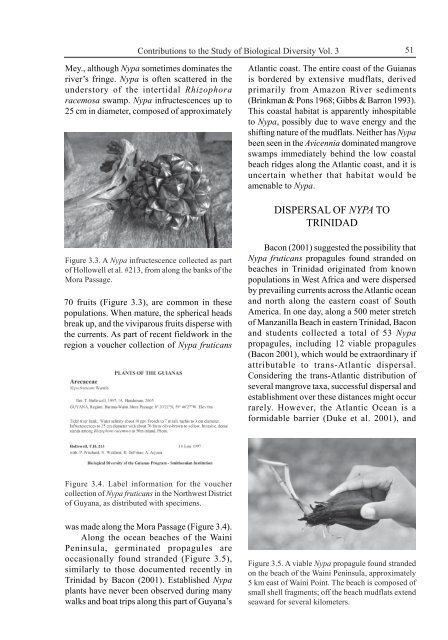Plant Community Structure, Fire Disturbance, and Recovery in ...
Plant Community Structure, Fire Disturbance, and Recovery in ...
Plant Community Structure, Fire Disturbance, and Recovery in ...
You also want an ePaper? Increase the reach of your titles
YUMPU automatically turns print PDFs into web optimized ePapers that Google loves.
Contributions to the Study of Biological Diversity Vol. 3<br />
Mey., although Nypa sometimes dom<strong>in</strong>ates the<br />
river’s fr<strong>in</strong>ge. Nypa is often scattered <strong>in</strong> the<br />
understory of the <strong>in</strong>tertidal Rhizophora<br />
racemosa swamp. Nypa <strong>in</strong>fructescences up to<br />
25 cm <strong>in</strong> diameter, composed of approximately<br />
Figure 3.3. A Nypa <strong>in</strong>fructescence collected as part<br />
of Hollowell et al. #213, from along the banks of the<br />
Mora Passage.<br />
70 fruits (Figure 3.3), are common <strong>in</strong> these<br />
populations. When mature, the spherical heads<br />
break up, <strong>and</strong> the viviparous fruits disperse with<br />
the currents. As part of recent fieldwork <strong>in</strong> the<br />
region a voucher collection of Nypa fruticans<br />
Figure 3.4. Label <strong>in</strong>formation for the voucher<br />
collection of Nypa fruticans <strong>in</strong> the Northwest District<br />
of Guyana, as distributed with specimens.<br />
was made along the Mora Passage (Figure 3.4).<br />
Along the ocean beaches of the Wa<strong>in</strong>i<br />
Pen<strong>in</strong>sula, germ<strong>in</strong>ated propagules are<br />
occasionally found str<strong>and</strong>ed (Figure 3.5),<br />
similarly to those documented recently <strong>in</strong><br />
Tr<strong>in</strong>idad by Bacon (2001). Established Nypa<br />
plants have never been observed dur<strong>in</strong>g many<br />
walks <strong>and</strong> boat trips along this part of Guyana’s<br />
51<br />
Atlantic coast. The entire coast of the Guianas<br />
is bordered by extensive mudflats, derived<br />
primarily from Amazon River sediments<br />
(Br<strong>in</strong>kman & Pons 1968; Gibbs & Barron 1993).<br />
This coastal habitat is apparently <strong>in</strong>hospitable<br />
to Nypa, possibly due to wave energy <strong>and</strong> the<br />
shift<strong>in</strong>g nature of the mudflats. Neither has Nypa<br />
been seen <strong>in</strong> the Avicennia dom<strong>in</strong>ated mangrove<br />
swamps immediately beh<strong>in</strong>d the low coastal<br />
beach ridges along the Atlantic coast, <strong>and</strong> it is<br />
uncerta<strong>in</strong> whether that habitat would be<br />
amenable to Nypa.<br />
DISPERSAL OF NYPA TO<br />
TRINIDAD<br />
Bacon (2001) suggested the possibility that<br />
Nypa fruticans propagules found str<strong>and</strong>ed on<br />
beaches <strong>in</strong> Tr<strong>in</strong>idad orig<strong>in</strong>ated from known<br />
populations <strong>in</strong> West Africa <strong>and</strong> were dispersed<br />
by prevail<strong>in</strong>g currents across the Atlantic ocean<br />
<strong>and</strong> north along the eastern coast of South<br />
America. In one day, along a 500 meter stretch<br />
of Manzanilla Beach <strong>in</strong> eastern Tr<strong>in</strong>idad, Bacon<br />
<strong>and</strong> students collected a total of 53 Nypa<br />
propagules, <strong>in</strong>clud<strong>in</strong>g 12 viable propagules<br />
(Bacon 2001), which would be extraord<strong>in</strong>ary if<br />
attributable to trans-Atlantic dispersal.<br />
Consider<strong>in</strong>g the trans-Atlantic distribution of<br />
several mangrove taxa, successful dispersal <strong>and</strong><br />
establishment over these distances might occur<br />
rarely. However, the Atlantic Ocean is a<br />
formidable barrier (Duke et al. 2001), <strong>and</strong><br />
Figure 3.5. A viable Nypa propagule found str<strong>and</strong>ed<br />
on the beach of the Wa<strong>in</strong>i Pen<strong>in</strong>sula, approximately<br />
5 km east of Wa<strong>in</strong>i Po<strong>in</strong>t. The beach is composed of<br />
small shell fragments; off the beach mudflats extend<br />
seaward for several kilometers.
















